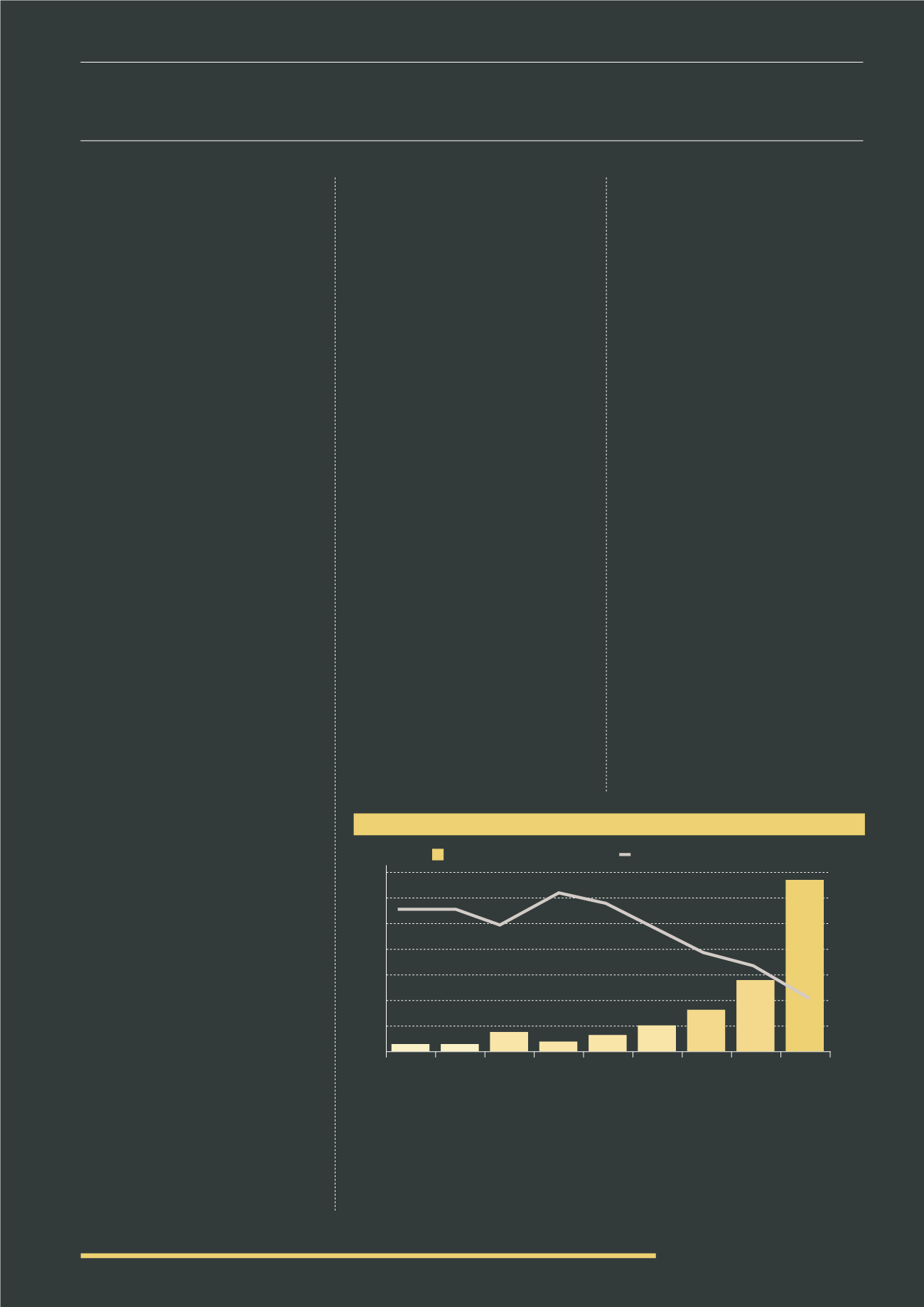
15
MEDIUM TO LONG TERM
In the medium to long term, returns
have proven to be strong, with the
Liv-ex Fine Wine Investables Index
achieving a compound annual return of
almost 15% over the 20 years to 2011.
26
In addition, two Switzerland-based
economists who compared wine prices
with the Russell 3000 Index between
January 1996 and January 2009, a
period which covers two bull markets
and two bear markets for stocks, found
that,“the inclusion of wine in a portfolio
and, especially, more prestigious
wines, increases the portfolio’s returns
while reducing its risk, particularly
during the financial crisis”
27
.
In the even longer term, the Telegraph
reported in 2014 that red wine
outperformed government bonds,
fine art and even stamps over the 20th
century, according to research by a
team of academics from the University
of Cambridge, HEC Paris and Vanderbilt
University, Nashville, Tennessee. The
research found that fine wine investors
could have earned annualised real
returns of 4.1% from 1900 to 2012,
although British equities would have
given annualised returns of 5.2%. “The
returns are surprisingly high compared
with the returns on cash or bonds”
Elroy Dimson, visiting professor at the
Cambridge Judge Business School, said.
29
SHORTER TERM
Certainly, in the last ten to fifteen
years, it has been a very active and
growing market, with fine wine
turnover quadrupling from US$1bn to
US$4bn between 2004 and 2010.
4
However, despite rallying in the last few
months of 2014, the Liv-ex 100 closed
the year on 238.50, representing a 7.3%
drop. Although the index rose 1.9%
from July to December 2014, it was the
fourth consecutive year of declines.
30
This has been largely due to the drop
in price of Bordeaux, which makes up a
large percentage of the overall market
where values dropped sharply since
mid 2011 - ‘Some 2009 first growths
are still only nearly back to 50%’. Lafite
2008, for example, once considered
the greatest investment wine because
superstitious Chinese prize the number
eight, peaked at £16,000 a case, but
Farrs were selling it in February at
£5,200.
20
This stubbornly slow rebound
is leaving room for longer term
investors to pick up undervalued stock,
so, after a decade of being a sellers
market, it is now a buyers market,
which is certainly beneficial for new
entrants. For existing investors, who are
able to follow a medium to long term
strategy, opinion is that the increasing
demand, nature of changing tastes,
the cyclical nature of the market and
the consumption of existing vintages,
creating more rarity, will, eventually,
bring Bordeaux which were overpriced
in 2011 back to positive growth figures.
Commentators, including Cult Wines
concede that the last several years of
performance have been challenging, but
feel that “While the economic conditions
in major economies such as the US and
Japan have improved, stock markets
have already had substantial gains and
the bull market is arguably entering
advanced stages. In contrast, fine wine
investment is now trending below
average and the odds of a potential
gain from “reversion to mean trend”
has become favourable should trading
environment for the fine wine market
turn more supportive. Thus, it is
highly probable that between the two
asset classes the relative performance
in the coming few years will shift
back to fine wine investments”.
A buyers market, allied with the potential
for a low entry level, makes a small
portfolio accessible to a wide range of
investors: with minimum investment
levels as low as £5,000, in order to build
a diverse portfolio and access stock
with the strongest growth potential.
Of course, the lower the entry level,
the less real prices need to appreciate
to provide growth in the asset value.
Market participants such as World of
Wine and James Miles of Liv-ex point
out that positive signs of overall growth
are now evident: toward the end of
last year and continuing into 2015,
some indices made gains, following
17 months of decline; the Liv-ex 100
index saw four months of (admittedly
modest) gains to November 2014 and
was flat in December. Half of the eight
sub-indices in the Liv-ex 1000 made
gains from June to December 2014,
most notably the Bordeaux 500.
Nevertheless, those savvy investors
who have diversified into other vintages
where better returns can still be found
“A buyers market, allied with the potential for a low entry level, makes a small portfolio accessible
to a wide range of investors”
Italy’s modern-day status as a source of investment-grade wine began with what are
now widely known as SuperTuscans, and these remain the key focus of investors,
tripling in price over the last decade (Chart on the next page). The Liv-ex SuperTuscan
index has not seen the peaks and troughs of the Bordeaux first growths, but has
climbed steadily, and despite flattening out over the last year, has proved a better
investment over two, five and 10 years.
ITALY SHARE OF TRADE ON LIV-EX
VS.
BORDEAUX (%)
(2007-2015)
2014
YTD
2014
Sep
2007 2008 2009 2010 2011 2012 2013
100%
95%
90%
85%
80%
75%
70%
65%
Italy (left hand axis)
Bordeaux (right hand axis)
Source: Liv-ex
14%
12%
10%
8%
6%
4%
2%
0


